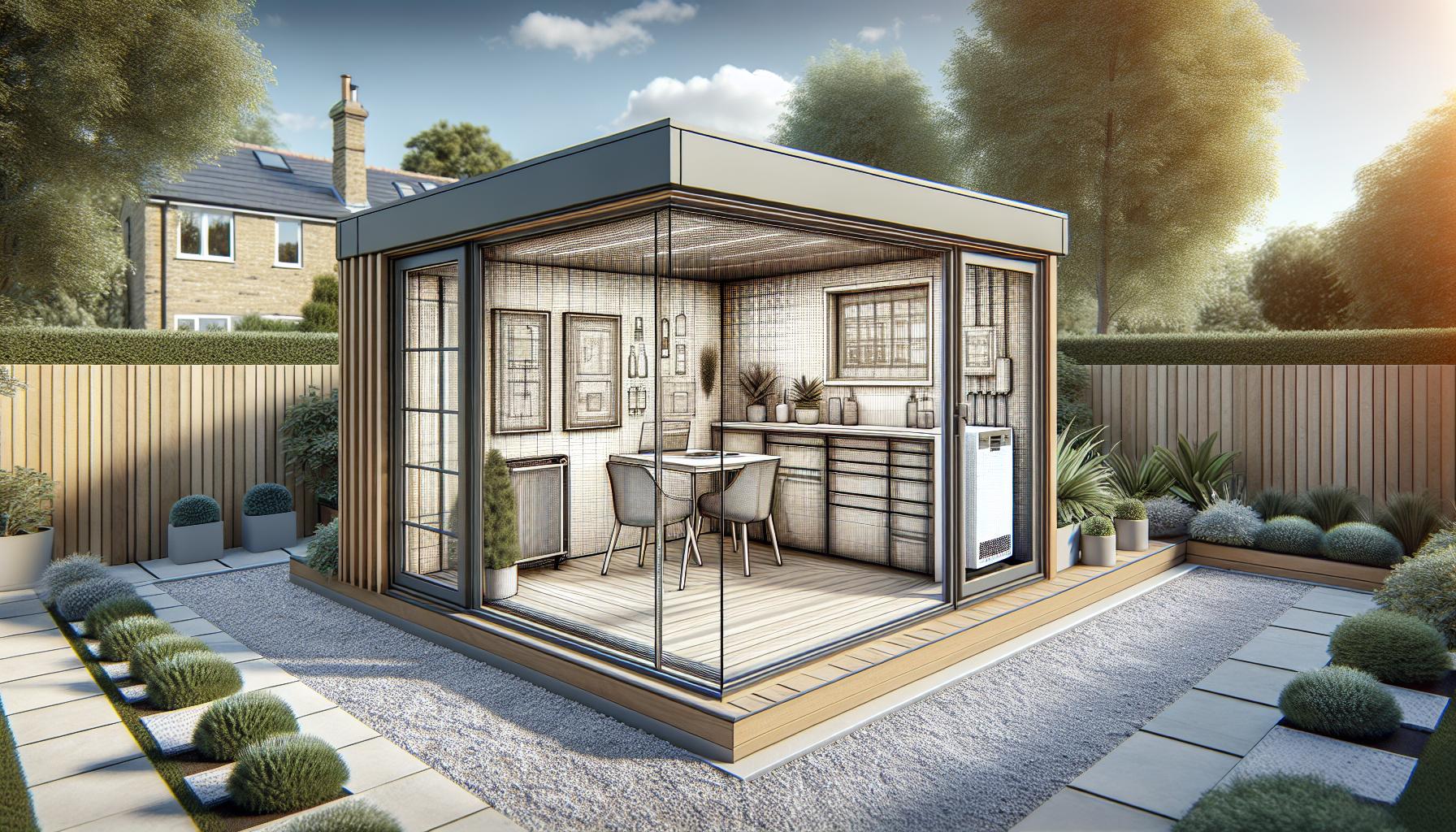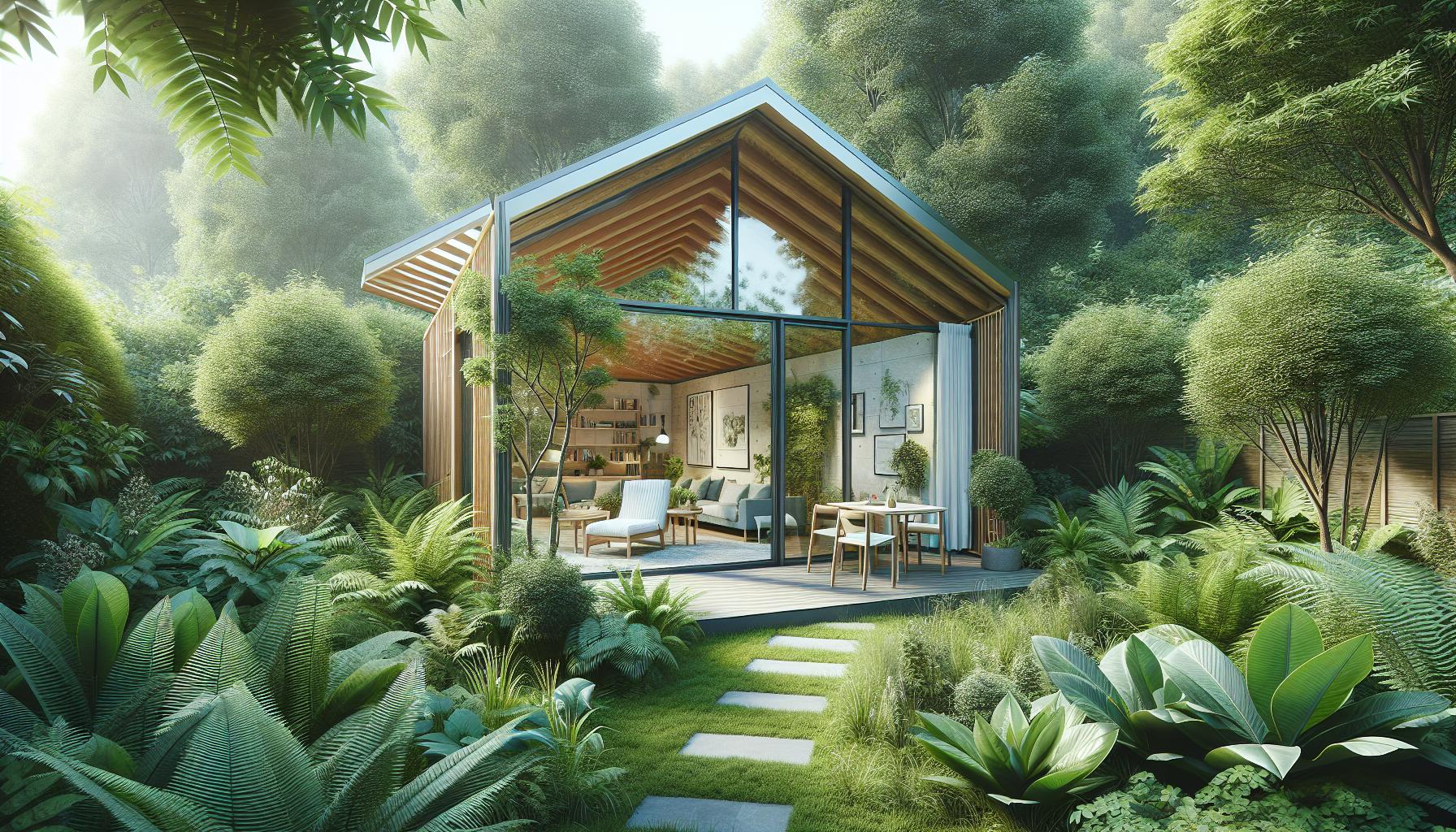Living in a UK Garden Room: Legalities, Design, and Comfort Tips
Ever wondered if you could turn that cosy garden room into your very own living space? With more of us looking for flexible, creative, and cost-effective living solutions, the idea of living in a garden room in the UK has never been more appealing. Whether it's transforming it into a sleek home office, a tranquil studio, or even a compact gym, the possibilities are endless.
But can you actually live in one? It's a question that's been on the minds of many, especially those looking to maximise their property's potential or seeking an alternative to traditional housing. Let's jump into the ins and outs of making a garden room your home, exploring the practicalities, legalities, and everything in between. Stick around, because this might just be the game-changer you've been looking for.
Benefits of living in a garden room
Picture yourself stepping into your very own garden room each morning. It's not just any space; it's your sanctuary, office, gym, or studio, nestled right in your backyard. Living in a garden room carries a bundle of benefits that might just be the game-changer you’ve been looking for.
**Firstly, the Peace and Quiet. Imagine working, exercising, or creating without the usual distractions. It's just you and your thoughts, with the gentle backdrop of nature. This serene separation from the main house means you can dive deep into your work or relax without interruption.
Cost-Effectiveness is another significant perk. Constructing a garden room is generally more affordable than traditional home extensions or moving to a larger property. You'll save on costs without sacrificing the quality of your living or working space. Plus, a well-built garden room can add value to your property, should you ever decide to sell.
Flexibility in design and usage is like having your cake and eating it too. Whether you need a home office, a studio, a gym, or even a cosy nook for reading, your garden room can be customized to suit your needs. The beauty lies in the versatility; your garden room can evolve as your needs do.
Environmentally Friendly options abound with garden rooms. Many are constructed with sustainable materials and can be equipped with eco-friendly features like solar panels and rainwater harvesting systems. By choosing a garden room, you're not only benefiting yourself but also making a positive impact on the environment.
Connecting With Nature has never been easier. With a garden room, you're just a step away from your own outdoor space. This connection to nature can boost your mood, increase productivity, and provide a sense of calm amidst the hustle and bustle of daily life.
So, as you can see, opting for a garden room isn’t just about adding an extra room. It’s about creating a lifestyle that blends functionality, peace, and a touch of nature. Whether you’re an artist seeking inspiration, a professional needing distraction-free space, or just someone who loves the idea of a unique retreat space, a garden room might just be the perfect solution for you.
Considerations before moving into a garden room

Before you pack your bags and make the leap into your new garden room dwelling, it's crucial to tick off a few considerations to ensure your transition is as smooth as peanut butter. Exploring these can mean the difference between a hiccup-free move and one that's, well, a bit more bumpy.
Planning Permissions
First things off, let's chat about planning permissions. It's a common misconception that you can just plonk a structure in your garden and call it home. The truth is, while many garden rooms fall under "permitted development," meaning you don't need planning permission, there are exceptions. Height restrictions, proximity to your property boundary, and the intended use of the garden room (living in it versus using it as an office, for instance) can all influence whether you need to get the green light from your local council. Think of it like a game of Monopoly, you wouldn’t build a hotel without buying the property first, right?
Utility Connections
Next, consider how you'll get the essentials to your garden room – we're talking water, electricity, and internet. Unlike setting up a tent in the wilderness, you'll need more than a flashlight and some bottled water. For electricity, you might need to run an armoured cable from your main house. Water and sewage connections can be trickier, possibly requiring a plumber to lay pipes. And unless you plan on disconnecting from the digital world entirely (not a bad thing, sometimes), figuring out your internet connection is a must. It’s like ensuring you have roads, water, and electricity before building a town on SimCity.
Insulation and Heating
Living comfortably means staying warm in winter and cool in summer. Insulation isn’t just about throwing on an extra jumper or opening a window; it's about creating a stable living environment. High-quality insulation in the walls, roof, and floor is your best friend here, alongside considering double-glazed windows and efficient heating solutions like underfloor heating or a split air conditioning unit. Think of your garden room as a thermos; you want your hot drinks hot and your cold drinks cold.
Understanding the legalities

Dipping your toes into the world of garden rooms in the UK isn't just about picking the perfect spot in your garden and starting construction. There's a maze of legalities you'll need to navigate to ensure everything's above board. Let's break it down into bite-sized pieces, shall we?
First off, planning permission is a term you'll come across frequently. Imagine planning permission as a green light from your local council, saying "Go ahead, build that dream garden room." Generally, garden rooms fall under "permitted development" and don't require this green light, but there are exceptions. If your home is listed or you live in a conservation area, you'll likely need to apply for permission. It's always better to check than face the headache of legal issues down the line.
Next up, building regulations. Think of these as a set of standards for design, construction, and alterations to virtually every building. They're there to ensure the safety and health for people in or around those buildings. For most garden rooms used as offices or gyms, you won't need to worry about these regulations, provided the structure is less than 15 square metres and doesn't contain sleeping accommodation. But, cross that threshold or add a bed, and you'll need to comply with the regulations.
A common mistake folks make is underestimating the importance of these legal aspects. It's not the most thrilling part of creating a garden room, sure, but overlooking it can lead to costly and time-consuming corrections later on. Always start your project with a clear understanding of the required permissions and regulations.
To avoid these pitfalls, here's what you should do:
Check your local council's website for specifics about planning permissions and building regulations. Each area can have its own set of rules.
Consult with professionals. A chat with an architect or builder specialising in garden rooms can clear up any confusion. They're your guide through the legal jungle.
Be neighborly. Informing your neighbours of your plans isn't just polite; it can preempt objections that might complicate your planning permission process.
By keeping these points in mind, you'll navigate the legal world smoothly and keep your focus on the exciting parts of bringing your garden room to life. Remember, a little legwork now saves a lot of headaches later.
Designing a garden room for living
When you're diving into the world of garden rooms, think of yourself as an artist with a blank canvas. But instead of paints and brushes, your tools are designs, materials, and the purpose of your garden room. Whether you're envisioning a cosy office space, a vibrant gym, or a tranquil studio, the key to bringing your garden room to life lies in thoughtful design and realistic planning.
First off, one common misconception is underestimating the importance of the foundation. Just like building a house without sturdy foundations is a recipe for disaster, skimping on your garden room's base can lead to issues down the line. This is not the corner to cut. Go for a solid, level foundation that can support your structure come rain or shine.
When choosing materials, there's a balancing act between aesthetics, durability, and budget. Sure, you might love the look of high-end materials, but if they're not within your budget or they require high maintenance, are they worth it? Practicality should be your guide here. Materials like treated wood, composite cladding, and aluminium frames strike a good balance, offering longevity without very costly.
Insulation is another aspect you can't afford to overlook. Living in the UK, you're well aware of the unpredictable weather. Proper insulation ensures your garden room is a comfortable retreat year-round, not just during the temperate seasons. Think of it as wrapping your space in a snug blanket that keeps the warmth in during winter and the heat out in the summer.
A common mistake is neglecting natural light. While artificial lighting is necessary, there's no substitute for the beauty and wellbeing benefits of natural light. Consider large windows or skylights to maximise sunlight entry, which not only makes the space more enjoyable but also helps regulate your body's natural rhythms.
About the interior layout, flexibility is your friend. Modular furniture and smart storage solutions can transform your garden room from a daytime office to an evening relaxation zone. This approach allows you to maximise the functionality of your space without committing to a single use.
Finally, the aesthetics of your garden room should reflect your personal style while complementing your home and garden. Whether you opt for a sleek, modern look or a warm, rustic feel, ensuring harmony between your garden room and its surroundings will enhance both its appeal and your overall outdoor experience.
Creating a comfortable living space
When you're pivoting towards the idea of making a garden room your next cozy corner or even a full-on living space in the UK, there's more to it than just splashing on a coat of paint and moving in furniture. Imagine dressing for the British weather; it's all about layers and suitability. Similarly, creating a lived-in feel within a garden room requires layering not just textures and materials but also practical considerations.
One common misconception is that any garden room will suffice for year-round living. But, without proper insulation, your garden haven could become a winter icebox or a summer sauna. Think of insulation as your garden room's coat, essential for keeping the warmth in during winter and the heat out during the summer. It's not just about comfort; it's about efficiency and reducing heating or cooling costs too.
Another aspect often overlooked is the importance of natural light. This isn't just about plonking a window here or there; it's about considering where the sun rises and sets and how the light will flow through your garden room throughout the day. Imagine how a well-placed window can turn into a reading nook bathed in morning light or an artist's studio with perfect north light. Skylights can also be a great addition, offering not just light but a glimpse of the sky, which can be extremely uplifting.
Ventilation is another key area. You might think cracking a window is enough, but proper ventilation systems are crucial for preventing condensation and ensuring a constant flow of fresh air. It's like ensuring your garden room can breathe, keeping the space fresh and mould-free.
And then there's the question of power and connectivity. In today's world, being connected is non-negotiable, whether it's for work, entertainment, or keeping in touch with loved ones. Planning for power sockets, internet connections, and even smart home technology from the start can save you from extension cord spaghetti and wifi signal quests later on.
So, before you jump into selecting furnishings or paint colors, think about these foundational elements. They might not be the most glamorous part of creating your garden room, but they're certainly the most critical for ensuring your space is comfortable, practical, and sustainable in the long run. Remember, it's not just about making a garden room liveable; it's about making it a home.
Key Takeaways
Versatility and Benefits: Garden rooms offer a flexible, cost-effective solution for adding space to your property, serving various functions from home offices to gyms, and can increase property value.
Planning Permissions and Legalities: Before converting a garden room into a living space, it's essential to understand and comply with local planning permissions and building regulations to avoid legal issues.
Designing for Livability: Effective design and planning, including foundational integrity, insulation, and natural lighting, are key to creating a comfortable, year-round living space in a garden room.
Comfort Considerations: To ensure a garden room is a viable living option, emphasis should be placed on insulation, natural light, proper ventilation, and connectivity, making it as comfortable and functional as a traditional home space.
Environmental and Lifestyle Perks: Living in a garden room can offer a unique blend of connectivity with nature, tranquility, and a more environmentally friendly footprint with the use of sustainable materials and features.
Conclusion
Living in a garden room in the UK offers a unique blend of tranquility, affordability, and a deep connection with nature. But, it's essential to approach this lifestyle change with careful planning and consideration. Ensuring you're well-informed about planning permissions, utility connections, and the importance of insulation and heating will pave the way for a smooth and enjoyable transition. Also, adhering to legal requirements and investing in thoughtful design and materials are crucial steps in creating a comfortable and sustainable living space. Focusing to these details, you'll be well on your way to enjoying the many benefits of garden room living. Remember, a successful garden room project isn't just about building a structure; it's about creating a home.
Frequently Asked Questions
What are the benefits of living in a garden room in the UK?
Living in a garden room in the UK offers peace and quiet, cost-effectiveness, flexibility in design, and a closer connection to nature. These factors combine to provide a tranquil and personalised living space.
Do I need planning permission for a garden room in the UK?
Yes, some garden rooms require planning permission, especially if they exceed certain sizes or are intended for permanent residency. It's crucial to check with your local council and adhere to specific regulations before construction.
What should I consider before moving into a garden room?
Before moving into a garden room, consider planning permissions, utility connections (electricity, water), and ensuring adequate insulation and heating to make the space comfortable year-round.
How do I ensure my garden room complies with UK building regulations?
To ensure compliance with UK building regulations, consulting with professionals, such as architects or builders who are familiar with the latest standards, is advisable. Additionally, checking your local council's guidelines can provide specific requirements.
Why is insulation important in a garden room?
Insulation is vital in a garden room for maintaining a comfortable temperature throughout the year. Proper insulation keeps the room warm in winter and cool in summer, reducing the need for excessive heating or cooling.
How can I maximise natural light in my garden room?
Maximising natural light in your garden room can be achieved through thoughtful design, such as incorporating large windows, skylights, or glass doors. Positioning the room to face sunlight at certain times of the day can also enhance light intake.
What are some tips for designing a garden room?
When designing a garden room, consider a solid foundation, choosing practical materials, proper insulation, maximising natural light, ensuring good ventilation, and planning for power and connectivity. These aspects are crucial for a comfortable, practical, and sustainable living space.



